The puzzle of the US jobs data
The US jobs data paints a gloomy picture of the state of the American economy. That's having an effect on the markets, says John C Burford. But not as you might expect.
Today is Martin Luther King Day in the US, and trading will be curtailed. So this morning, I will cover a critical macro topic that seems to get many investors worked up - the US jobs picture.
Stock markets have zeroed in on this subject above most others. Now, even the Fed has changedits emphasis from suppressing inflation to promoting employment.It haspledged to do everything to bringunemployment down.
Many have interpreted this as a green light to ramp up asset markets including gold until the unemployment rate drops to 6.5% (currently 7.8% and falling).
MoneyWeek
Subscribe to MoneyWeek today and get your first six magazine issues absolutely FREE

Sign up to Money Morning
Don't miss the latest investment and personal finances news, market analysis, plus money-saving tips with our free twice-daily newsletter
Don't miss the latest investment and personal finances news, market analysis, plus money-saving tips with our free twice-daily newsletter
And that is what we are seeing currently.
But as we all know, the link between asset prices and employment is tenuous at best.
What's happening with the jobs data?
This is the headline unemployment rate in graph form:
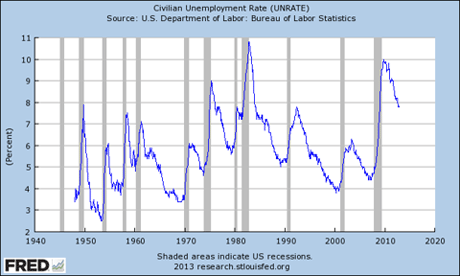
But with GDP growth subdued, there appears to be an inconsistency between output and employment.
Why, if many jobs are being created, is GDP not keeping up?
The answer is probably this:many workers are leaving the workforce, which reduces the pool of labour and lowers the unemployment rate.
This fascinating chart shows the labour participation rate:
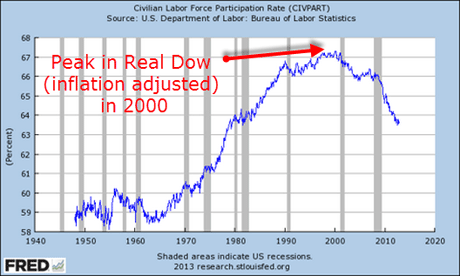
The rate peaked in 2000 at 67% and is now falling rapidly and lies under 64% at present.
Even in the lastfour years,ten million people have left the labour force.That is a lot of people on food stamps, benefits, and living off savings or emigrating!
One other factor is the demographic one the population is ageing, as it is in most Western economies.The baby boomers are retiring. And the dependency ratio is falling it is taking more workers to support a growing number of dependents.
But one thing caught my eye when I first saw the above chart:the peak in 2000 occurred at the same time as the Dow Jones Industrials peaked in real terms (adjusted for CPI).
That set me thinking.Could it be that the economy started to contract in 2000 (in real terms) and made jobs more difficult to keep and get?
One measure of this is to look at the part-time jobs data. It is all very well counting people in jobs, but are they well-paid, full-time ones?
Here is the part-time jobs data:
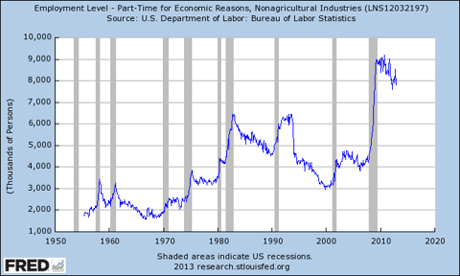
For the past six years since the Credit Crunch the number of part-timers (for economic reasons) has ballooned and has only just stabilised since hitting the peak during a period when the stock bulls have proclaimed the economy is growing healthily.
I mentioned those that have come out of the labour force or are on part-time work and are using food stamps (the government programme is called SNAP (incidentally, a term used in the UK for food!).Well, here is the data:

There are 45 million people currently using SNAP a staggering 21% of the population.
This is on a par with European dependency programmes. The USA is now just as socialist as Europe.
This will have severe implications for the economy, as it already has hadin Europe.
And this is definitely not a healthy US economy. The SNAP figures help explain why the very rich professional money managers (who are buying stocks) are bullish, while the average Joe is much more gloomy.
But remember, the stock market is not the economy!I have seen periods when the economy was lousy and stocks in a bull market, and vice versa.
Euro update
I will follow up on the euro from my post of 14 January, as it is deciding whether to rally above the 1.34 high, or descend back to my tramline.This is the updated daily chart:
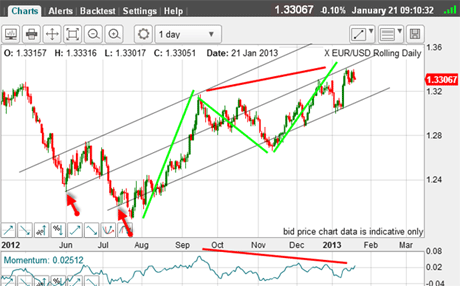
(Click on the chart for a larger version)
I now have three tramlines, and the original two lower ones are sporting good prior pivot points (PPPs- red arrows).My new upper tramline has two excellent touch points.
OK, the rally off the July low can be counted as an A-B-C, which means I should be looking for a wave C top soon.
Also, there is a potential large negative momentum divergence (red bars) which adds to the bearish case.
Last week, the market hit the centre tramline at 1.34.Is this the end of the rally?
Let's zoom in on the short-term picture:
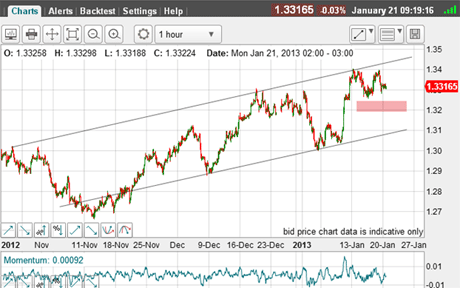
(Click on the chart for a larger version)
The weak spot for the bullish case is the area under the most recent minor low in the pink zone. A move there could herald a move back down to the lower tramline.
But at present, the trend is up.
If you're a new reader, or need a reminder about some of the methods I refer to in my trades, then do have a look at my introductory videos:
The essentials of tramline trading
An introduction to Elliott wave theory
Advanced trading with Elliott waves
Don't miss my next trading insight. To receive all my spread betting blog posts by email, as soon as I've written them, just sign up here . If you have any queries regarding MoneyWeek Trader, please contact us here.
Get the latest financial news, insights and expert analysis from our award-winning MoneyWeek team, to help you understand what really matters when it comes to your finances.
John is is a British-born lapsed PhD physicist, who previously worked for Nasa on the Mars exploration team. He is a former commodity trading advisor with the US Commodities Futures Trading Commission, and worked in a boutique futures house in California in the 1980s.
He was a partner in one of the first futures newsletter advisory services, based in Washington DC, specialising in pork bellies and currencies. John is primarily a chart-reading trader, having cut his trading teeth in the days before PCs.
As well as his work in the financial world, he has launched, run and sold several 'real' businesses producing 'real' products.
-
 Zoopla: house price growth stalled in 2025 but forecasts for 1.5% higher next year
Zoopla: house price growth stalled in 2025 but forecasts for 1.5% higher next yearSales soared this year with more than a million deals done but buyers drove hard bargains keeping a lid on prices. A small bounceback in valuations is predicted for 2026, depending on where you live.
-
 UK sets out crypto regulatory proposals
UK sets out crypto regulatory proposalsThe government has tabled legislation that sets out a regulatory framework for cryptocurrencies, while the regulator will consult on balancing innovation and consumer protections